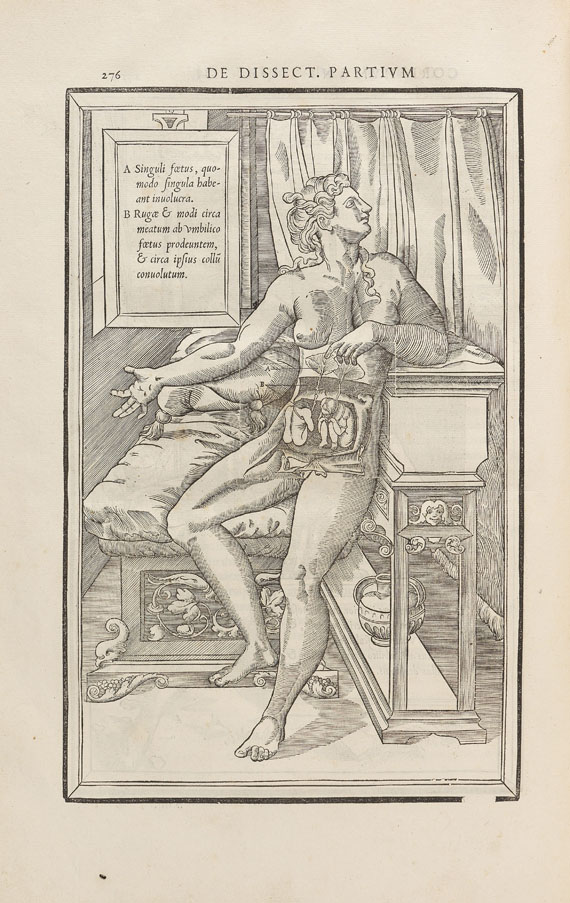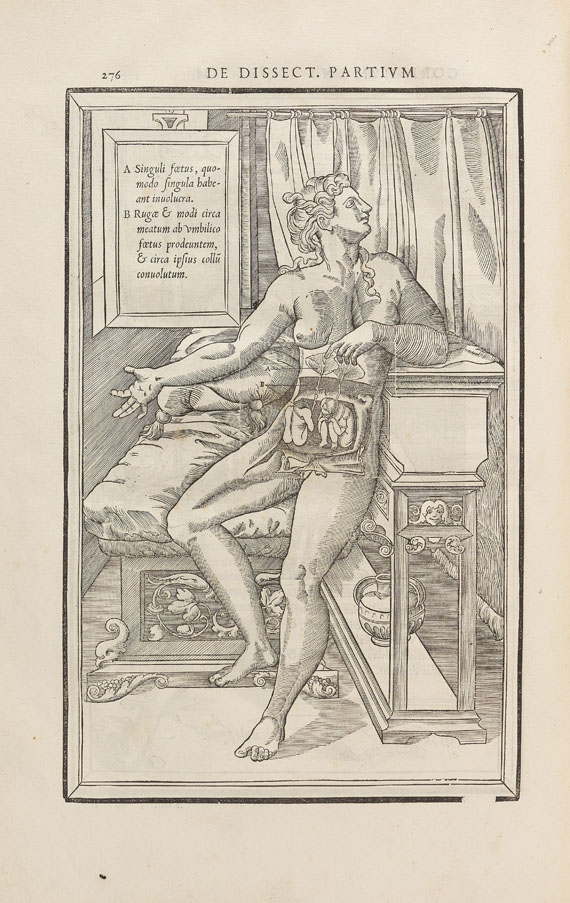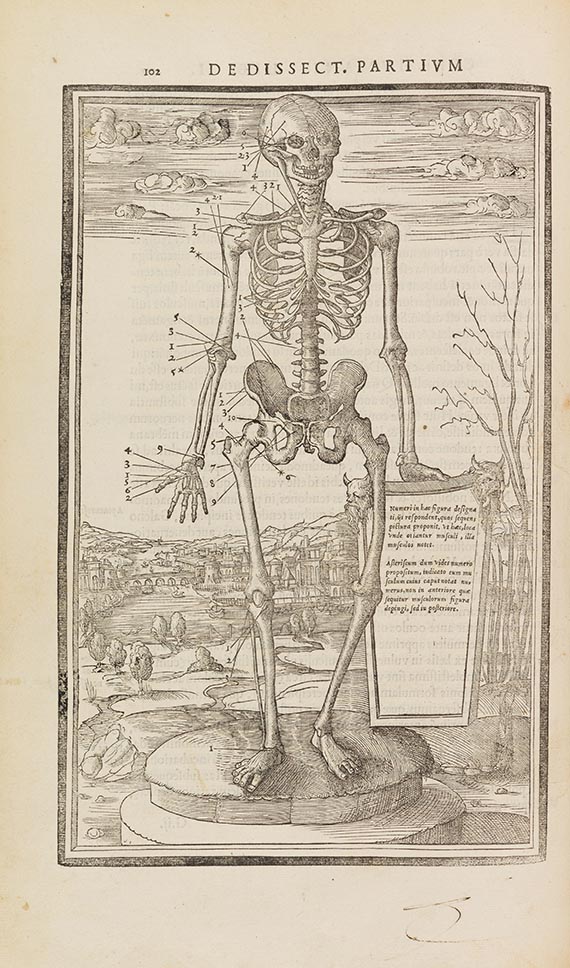ESTIENNE, Charles (ca. 1505-1564). De dissectione partium corporis humani libri tres. Un cum figuris, & incisionum declarationibus, Stephano Riverio Chirurgo compositis . Paris: Simon de Colines, 1545. Large 2 o (391 x 256 mm). Collation: *-** 6 ; A-Z 8 AA 6 . 202 leaves. Roman type, side-notes and index in italic. Printer's woodcut device (Schreiber's "Tempus I") on title. 62 full-page woodcut illustrations printed from 56 blocks, one signed S.R. (Stephanus Riverius), 7 others signed by Jean Jollat either with his name or with his Mercury symbol, a few dated 1530, 1531 or 1532, 4 of these plus one other cut signed with the Lorraine cross and cut by the Tory master (Jacquemin Woeiriot?), 101 small woodcut diagrams in the text (including repeats). 9-, 6- and 3-line white-on-black cribl initials, a few 3-line woodcut initials. (Marginal foxing, some spotting in quires L-S, marginal soiling to title, leaves in first 2 quires tearing slightly along upper gutters, a few minor marginal wormholes at front, short marginal tears to 4 or 5 leaves.) Contemporary binding of vellum over pasteboard, the upper layer of the boards from a 14th-century manuscript in a small gothic script, contemporary manuscript title lettering along lower edges, later lettering on upper cover and spine, traces of four pairs of ties (18th-century vellum rebacking, some where). Provenance : A few marginalia in a contemporary hand; Carolo Moadini (early owner's signature). FIRST EDITION of one of the most important anatomical works of the sixteenth century, and the finest printed medical book of the French Renaissance. Charles Estienne, third son of the printer Henri I Estienne, studied botany, horticulture, and classical philology before concentrating exclusively on medicine. From 1544 to 1547 he held the post of lecturer in anatomy at the Facult de Mdecine in Paris; during this same period his stepfather Simon de Colines carried out the printing of both the Latin and French editions of this anatomy, his major scientific work. Estienne was later obliged to give up his medical practice in order to manage the family printing business, but he continued to edit and compile scientific texts in such diverse areas as diet, zoology, philology, and rural economy. Although published after Vesalius's Fabrica , the preparation of De dissectione was undertaken no later than 1530, the earliest date to appear on one of the woodcuts, and in 1536 a formal publication contract was drawn up between Estienne, still a medical student at the time, his stepfather de Colines, and the barber-surgeon Etienne de la Rivire, who agreed to supply the "portraits" of bones, ligaments and other anatomical details, as well as the depictions of dissections. The bulk of the work was completed by 1539, when printing was interrupted by a lawsuit brought by de la Rivire, who accused Estienne of plagiarizing one of his manuscripts and of claiming exclusive credit for the work. The dispute dragged on for six years -- during which time Vesalius published the first edition of the Fabrica -- until it was finally resolved by a special commission of doctors and surgeons appointed by the Parlement, resulting in a parliamentary judgement in March 1545 ordering Estienne to include de la Rivire's name on the title, and obliging the latter to hand over the remainder of the outstanding illustrations and reimburse Estienne for the expenses incurred by the litigation. This delay in publication was significant, for it permanently obscured the importance of Estienne's work. Not only was his treatise the first printed book to illustrate in its entirety the external venous and nervous systems, but it reaffirmed before Vesalius the empirical principle formulated by Berengario of the necessity of basing the study of anatomy on the physician's observations of his own dissections. It was in fact the "first work to show detailed illustrations of dissection in serial progression, the first to discuss and illustrate the
ESTIENNE, Charles (ca. 1505-1564). De dissectione partium corporis humani libri tres. Un cum figuris, & incisionum declarationibus, Stephano Riverio Chirurgo compositis . Paris: Simon de Colines, 1545. Large 2 o (391 x 256 mm). Collation: *-** 6 ; A-Z 8 AA 6 . 202 leaves. Roman type, side-notes and index in italic. Printer's woodcut device (Schreiber's "Tempus I") on title. 62 full-page woodcut illustrations printed from 56 blocks, one signed S.R. (Stephanus Riverius), 7 others signed by Jean Jollat either with his name or with his Mercury symbol, a few dated 1530, 1531 or 1532, 4 of these plus one other cut signed with the Lorraine cross and cut by the Tory master (Jacquemin Woeiriot?), 101 small woodcut diagrams in the text (including repeats). 9-, 6- and 3-line white-on-black cribl initials, a few 3-line woodcut initials. (Marginal foxing, some spotting in quires L-S, marginal soiling to title, leaves in first 2 quires tearing slightly along upper gutters, a few minor marginal wormholes at front, short marginal tears to 4 or 5 leaves.) Contemporary binding of vellum over pasteboard, the upper layer of the boards from a 14th-century manuscript in a small gothic script, contemporary manuscript title lettering along lower edges, later lettering on upper cover and spine, traces of four pairs of ties (18th-century vellum rebacking, some where). Provenance : A few marginalia in a contemporary hand; Carolo Moadini (early owner's signature). FIRST EDITION of one of the most important anatomical works of the sixteenth century, and the finest printed medical book of the French Renaissance. Charles Estienne, third son of the printer Henri I Estienne, studied botany, horticulture, and classical philology before concentrating exclusively on medicine. From 1544 to 1547 he held the post of lecturer in anatomy at the Facult de Mdecine in Paris; during this same period his stepfather Simon de Colines carried out the printing of both the Latin and French editions of this anatomy, his major scientific work. Estienne was later obliged to give up his medical practice in order to manage the family printing business, but he continued to edit and compile scientific texts in such diverse areas as diet, zoology, philology, and rural economy. Although published after Vesalius's Fabrica , the preparation of De dissectione was undertaken no later than 1530, the earliest date to appear on one of the woodcuts, and in 1536 a formal publication contract was drawn up between Estienne, still a medical student at the time, his stepfather de Colines, and the barber-surgeon Etienne de la Rivire, who agreed to supply the "portraits" of bones, ligaments and other anatomical details, as well as the depictions of dissections. The bulk of the work was completed by 1539, when printing was interrupted by a lawsuit brought by de la Rivire, who accused Estienne of plagiarizing one of his manuscripts and of claiming exclusive credit for the work. The dispute dragged on for six years -- during which time Vesalius published the first edition of the Fabrica -- until it was finally resolved by a special commission of doctors and surgeons appointed by the Parlement, resulting in a parliamentary judgement in March 1545 ordering Estienne to include de la Rivire's name on the title, and obliging the latter to hand over the remainder of the outstanding illustrations and reimburse Estienne for the expenses incurred by the litigation. This delay in publication was significant, for it permanently obscured the importance of Estienne's work. Not only was his treatise the first printed book to illustrate in its entirety the external venous and nervous systems, but it reaffirmed before Vesalius the empirical principle formulated by Berengario of the necessity of basing the study of anatomy on the physician's observations of his own dissections. It was in fact the "first work to show detailed illustrations of dissection in serial progression, the first to discuss and illustrate the














.jpg)
Testen Sie LotSearch und seine Premium-Features 7 Tage - ohne Kosten!
Lassen Sie sich automatisch über neue Objekte in kommenden Auktionen benachrichtigen.
Suchauftrag anlegen